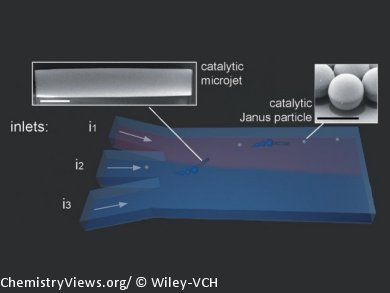Chemotaxis is the ability of systems to react to chemical gradients in their surroundings, for example, microoganisms that migrate towards gradients.
Samuel Sanchez and colleagues, Leibniz Institute for Solid State and Materials Research, Dresden, Germany, have shown that differently shaped micromotors undergo chemotactic attraction toward high concentrations of hydrogen peroxide in a microfluidic device. They studied the artificial chemotactic behavior of catalytic tubular microjets and Janus particles, which have different shapes and dimensions, in a liquid so as to rule out any effects from capillary forces at the air−liquid interface.
For their investigations they designed a three-input parallel-flow device (pictured), in which the micromotors flow in the central channel, while the hydrogen peroxide fuel and water flow in the outer channels. The catalytic tubular microjets and Janus particles oriented and deviated towards higher hydrogen peroxide concentrations, with the Janus particles being more sensitive to the fuel gradient. This behavior is probably related to the difference in translational and rotational diffusion of the two types of object, as the spherical particles rotate more easily than the tubular objects. The motion of the microtubes was found to be straighter than that of the spheres.
Although the exact mechanism of the attraction to the fuel gradient is not yet clearly understood, this study shows that artificial micromotors can sense their environments and can be directed to a specific location. Sanchez and his team believe that this principle can be applied to systems that react to species such as environmental pollutants.
- Chemotactic Behavior of Catalytic Motors in Microfluidic Channels,
Larysa Baraban, Stefan M. Harazim, Samuel Sanchez, Oliver G. Schmidt,
Angew. Chem. Int. Ed. 2013.
DOI: 10.1002/anie.201301460




